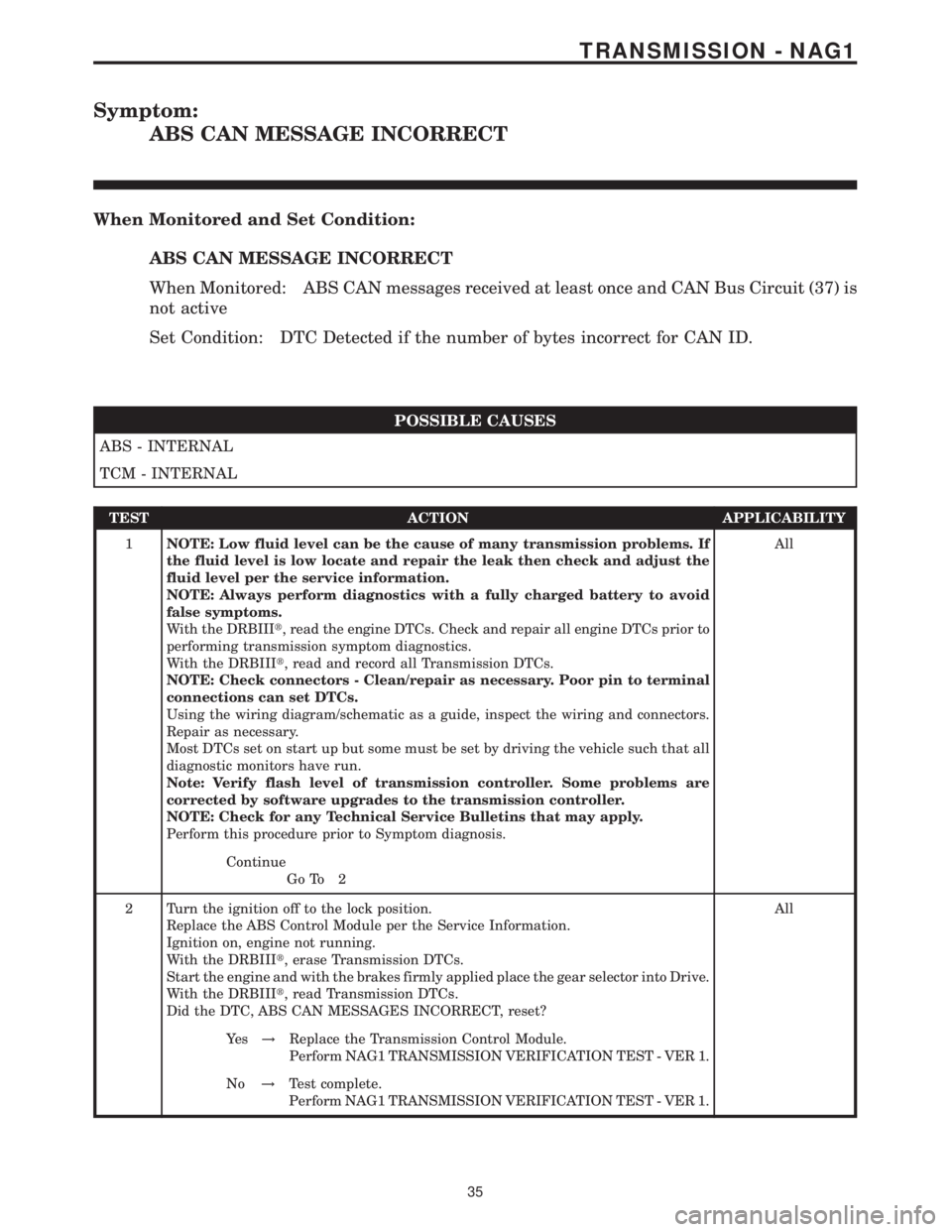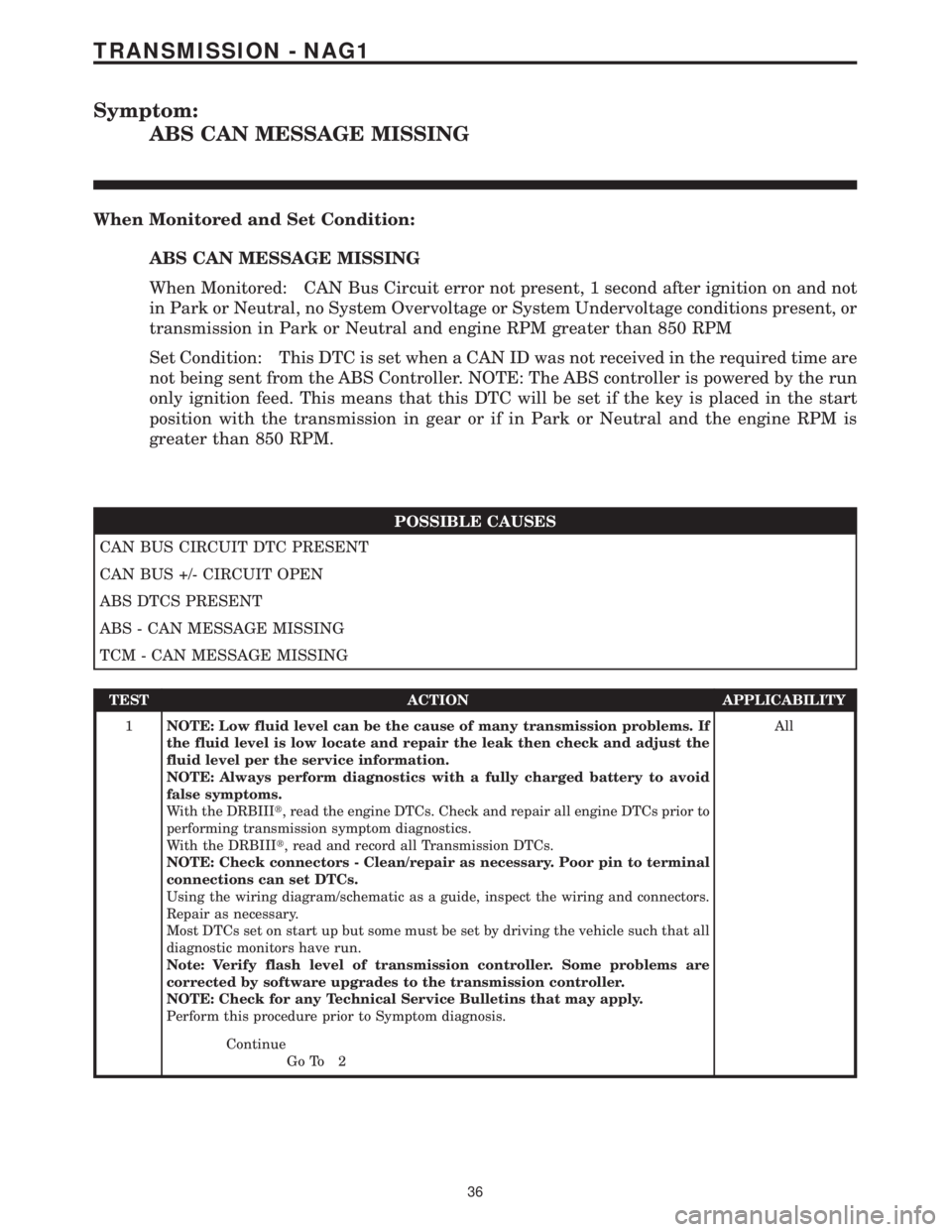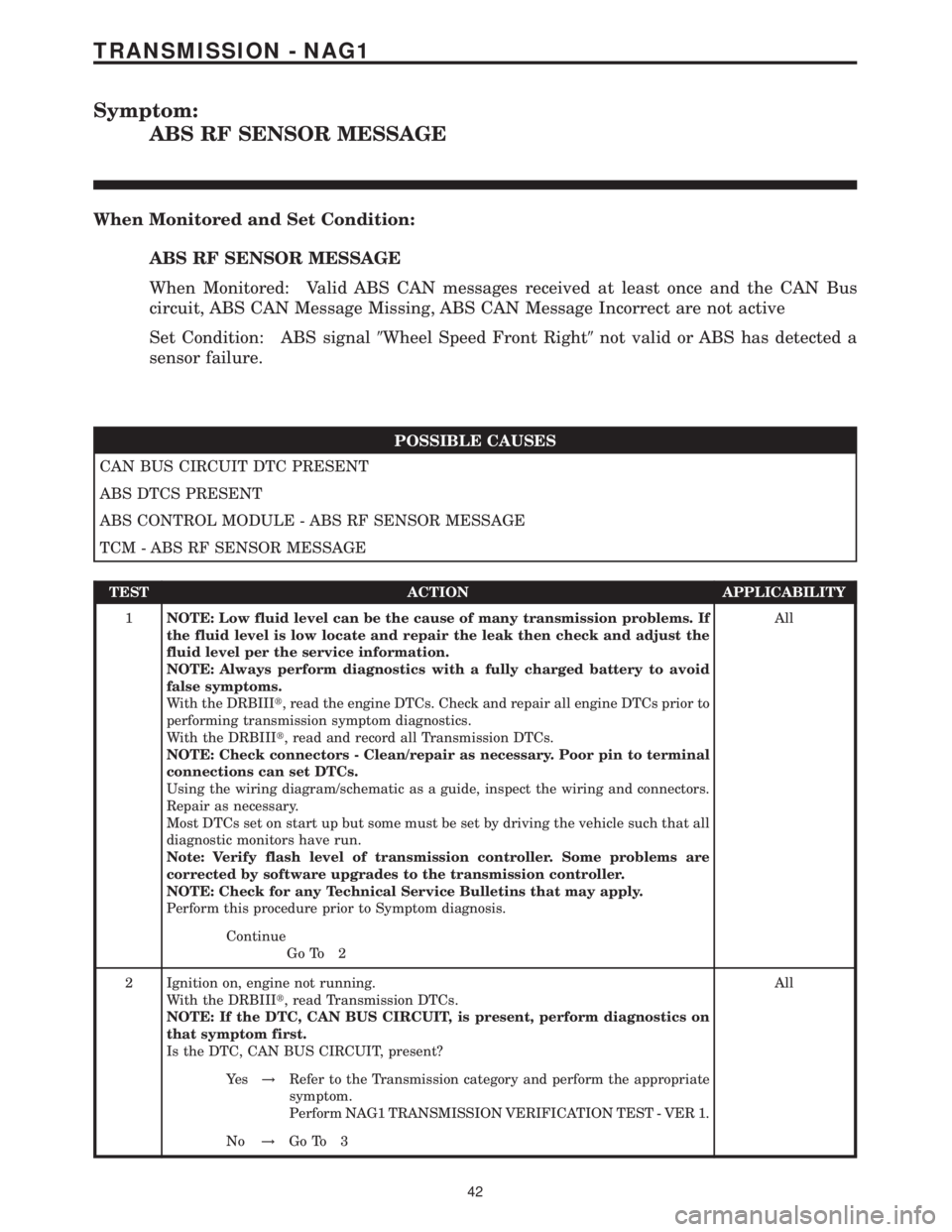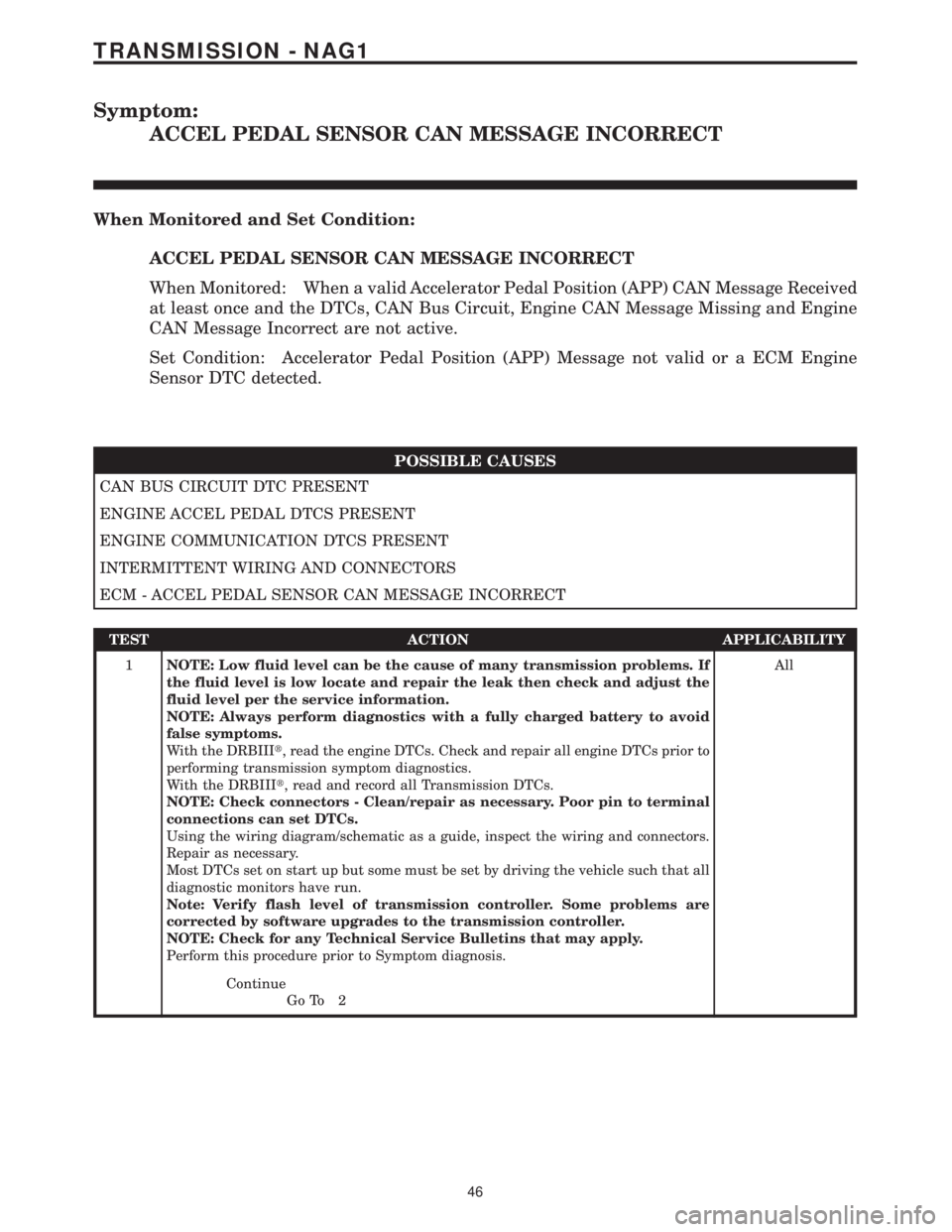2006 MERCEDES-BENZ SPRINTER transmission fluid
[x] Cancel search: transmission fluidPage 2200 of 2305

Symptom:
ABS CAN MESSAGE INCORRECT
When Monitored and Set Condition:
ABS CAN MESSAGE INCORRECT
When Monitored: ABS CAN messages received at least once and CAN Bus Circuit (37) is
not active
Set Condition: DTC Detected if the number of bytes incorrect for CAN ID.
POSSIBLE CAUSES
ABS - INTERNAL
TCM - INTERNAL
TEST ACTION APPLICABILITY
1NOTE: Low fluid level can be the cause of many transmission problems. If
the fluid level is low locate and repair the leak then check and adjust the
fluid level per the service information.
NOTE: Always perform diagnostics with a fully charged battery to avoid
false symptoms.
With the DRBIIIt, read the engine DTCs. Check and repair all engine DTCs prior to
performing transmission symptom diagnostics.
With the DRBIIIt, read and record all Transmission DTCs.
NOTE: Check connectors - Clean/repair as necessary. Poor pin to terminal
connections can set DTCs.
Using the wiring diagram/schematic as a guide, inspect the wiring and connectors.
Repair as necessary.
Most DTCs set on start up but some must be set by driving the vehicle such that all
diagnostic monitors have run.
Note: Verify flash level of transmission controller. Some problems are
corrected by software upgrades to the transmission controller.
NOTE: Check for any Technical Service Bulletins that may apply.
Perform this procedure prior to Symptom diagnosis.All
Continue
Go To 2
2 Turn the ignition off to the lock position.
Replace the ABS Control Module per the Service Information.
Ignition on, engine not running.
With the DRBIIIt, erase Transmission DTCs.
Start the engine and with the brakes firmly applied place the gear selector into Drive.
With the DRBIIIt, read Transmission DTCs.
Did the DTC, ABS CAN MESSAGES INCORRECT, reset?All
Ye s!Replace the Transmission Control Module.
Perform NAG1 TRANSMISSION VERIFICATION TEST - VER 1.
No!Test complete.
Perform NAG1 TRANSMISSION VERIFICATION TEST - VER 1.
35
TRANSMISSION - NAG1
Page 2201 of 2305

Symptom:
ABS CAN MESSAGE MISSING
When Monitored and Set Condition:
ABS CAN MESSAGE MISSING
When Monitored: CAN Bus Circuit error not present, 1 second after ignition on and not
in Park or Neutral, no System Overvoltage or System Undervoltage conditions present, or
transmission in Park or Neutral and engine RPM greater than 850 RPM
Set Condition: This DTC is set when a CAN ID was not received in the required time are
not being sent from the ABS Controller. NOTE: The ABS controller is powered by the run
only ignition feed. This means that this DTC will be set if the key is placed in the start
position with the transmission in gear or if in Park or Neutral and the engine RPM is
greater than 850 RPM.
POSSIBLE CAUSES
CAN BUS CIRCUIT DTC PRESENT
CAN BUS +/- CIRCUIT OPEN
ABS DTCS PRESENT
ABS - CAN MESSAGE MISSING
TCM - CAN MESSAGE MISSING
TEST ACTION APPLICABILITY
1NOTE: Low fluid level can be the cause of many transmission problems. If
the fluid level is low locate and repair the leak then check and adjust the
fluid level per the service information.
NOTE: Always perform diagnostics with a fully charged battery to avoid
false symptoms.
With the DRBIIIt, read the engine DTCs. Check and repair all engine DTCs prior to
performing transmission symptom diagnostics.
With the DRBIIIt, read and record all Transmission DTCs.
NOTE: Check connectors - Clean/repair as necessary. Poor pin to terminal
connections can set DTCs.
Using the wiring diagram/schematic as a guide, inspect the wiring and connectors.
Repair as necessary.
Most DTCs set on start up but some must be set by driving the vehicle such that all
diagnostic monitors have run.
Note: Verify flash level of transmission controller. Some problems are
corrected by software upgrades to the transmission controller.
NOTE: Check for any Technical Service Bulletins that may apply.
Perform this procedure prior to Symptom diagnosis.All
Continue
Go To 2
36
TRANSMISSION - NAG1
Page 2203 of 2305

Symptom:
ABS LF SENSOR MESSAGE
When Monitored and Set Condition:
ABS LF SENSOR MESSAGE
When Monitored: Valid ABS CAN messages received at least once and the CAN Bus
circuit, ABS CAN Message Missing, ABS CAN Message Incorrect are not active
Set Condition: ABS signal9Wheel Speed Front Left9not valid or ABS has detected a
sensor failure.
POSSIBLE CAUSES
CAN BUS CIRCUIT DTC PRESENT
ABS DTCS PRESENT
ABS CONTROL MODULE - ABS LF SENSOR MESSAGE
TCM - ABS LF SENSOR MESSAGE
TEST ACTION APPLICABILITY
1NOTE: Low fluid level can be the cause of many transmission problems. If
the fluid level is low locate and repair the leak then check and adjust the
fluid level per the service information.
NOTE: Always perform diagnostics with a fully charged battery to avoid
false symptoms.
With the DRBIIIt, read the engine DTCs. Check and repair all engine DTCs prior to
performing transmission symptom diagnostics.
With the DRBIIIt, read and record all Transmission DTCs.
NOTE: Check connectors - Clean/repair as necessary. Poor pin to terminal
connections can set DTCs.
Using the wiring diagram/schematic as a guide, inspect the wiring and connectors.
Repair as necessary.
Most DTCs set on start up but some must be set by driving the vehicle such that all
diagnostic monitors have run.
Note: Verify flash level of transmission controller. Some problems are
corrected by software upgrades to the transmission controller.
NOTE: Check for any Technical Service Bulletins that may apply.
Perform this procedure prior to Symptom diagnosis.All
Continue
Go To 2
2 Ignition on, engine not running.
With the DRBIIIt, read Transmission DTCs.
NOTE: If the DTC, CAN BUS CIRCUIT, is present, perform diagnostics on
that symptom first.
Is the DTC, CAN BUS CIRCUIT, present?All
Ye s!Refer to the Transmission category and perform the appropriate
symptom.
Perform NAG1 TRANSMISSION VERIFICATION TEST - VER 1.
No!Go To 3
38
TRANSMISSION - NAG1
Page 2205 of 2305

Symptom:
ABS LR SENSOR MESSAGE
When Monitored and Set Condition:
ABS LR SENSOR MESSAGE
When Monitored: Valid ABS CAN messages received at least once and the CAN Bus
circuit, ABS CAN Message Missing, ABS CAN Message Incorrect are not active
Set Condition: ABS signal9wheel speed rear left9not valid or ABS has detected a sensor
failure.
POSSIBLE CAUSES
CAN BUS CIRCUIT DTC PRESENT
ABS DTCS PRESENT
ABS CONTROL MODULE - ABS LR SENSOR MESSAGE
TCM - ABS LR SENSOR MESSAGE
TEST ACTION APPLICABILITY
1NOTE: Low fluid level can be the cause of many transmission problems. If
the fluid level is low locate and repair the leak then check and adjust the
fluid level per the service information.
NOTE: Always perform diagnostics with a fully charged battery to avoid
false symptoms.
With the DRBIIIt, read the engine DTCs. Check and repair all engine DTCs prior to
performing transmission symptom diagnostics.
With the DRBIIIt, read and record all Transmission DTCs.
NOTE: Check connectors - Clean/repair as necessary. Poor pin to terminal
connections can set DTCs.
Using the wiring diagram/schematic as a guide, inspect the wiring and connectors.
Repair as necessary.
Most DTCs set on start up but some must be set by driving the vehicle such that all
diagnostic monitors have run.
Note: Verify flash level of transmission controller. Some problems are
corrected by software upgrades to the transmission controller.
NOTE: Check for any Technical Service Bulletins that may apply.
Perform this procedure prior to Symptom diagnosis.All
Continue
Go To 2
2 Ignition on, engine not running.
With the DRBIIIt, read Transmission DTCs.
NOTE: If the DTC, CAN BUS CIRCUIT, is present, perform diagnostics on
that symptom first.
Is the DTC, CAN BUS CIRCUIT, present?All
Ye s!Refer to the Transmission category and perform the appropriate
symptom.
Perform NAG1 TRANSMISSION VERIFICATION TEST - VER 1.
No!Go To 3
40
TRANSMISSION - NAG1
Page 2207 of 2305

Symptom:
ABS RF SENSOR MESSAGE
When Monitored and Set Condition:
ABS RF SENSOR MESSAGE
When Monitored: Valid ABS CAN messages received at least once and the CAN Bus
circuit, ABS CAN Message Missing, ABS CAN Message Incorrect are not active
Set Condition: ABS signal9Wheel Speed Front Right9not valid or ABS has detected a
sensor failure.
POSSIBLE CAUSES
CAN BUS CIRCUIT DTC PRESENT
ABS DTCS PRESENT
ABS CONTROL MODULE - ABS RF SENSOR MESSAGE
TCM - ABS RF SENSOR MESSAGE
TEST ACTION APPLICABILITY
1NOTE: Low fluid level can be the cause of many transmission problems. If
the fluid level is low locate and repair the leak then check and adjust the
fluid level per the service information.
NOTE: Always perform diagnostics with a fully charged battery to avoid
false symptoms.
With the DRBIIIt, read the engine DTCs. Check and repair all engine DTCs prior to
performing transmission symptom diagnostics.
With the DRBIIIt, read and record all Transmission DTCs.
NOTE: Check connectors - Clean/repair as necessary. Poor pin to terminal
connections can set DTCs.
Using the wiring diagram/schematic as a guide, inspect the wiring and connectors.
Repair as necessary.
Most DTCs set on start up but some must be set by driving the vehicle such that all
diagnostic monitors have run.
Note: Verify flash level of transmission controller. Some problems are
corrected by software upgrades to the transmission controller.
NOTE: Check for any Technical Service Bulletins that may apply.
Perform this procedure prior to Symptom diagnosis.All
Continue
Go To 2
2 Ignition on, engine not running.
With the DRBIIIt, read Transmission DTCs.
NOTE: If the DTC, CAN BUS CIRCUIT, is present, perform diagnostics on
that symptom first.
Is the DTC, CAN BUS CIRCUIT, present?All
Ye s!Refer to the Transmission category and perform the appropriate
symptom.
Perform NAG1 TRANSMISSION VERIFICATION TEST - VER 1.
No!Go To 3
42
TRANSMISSION - NAG1
Page 2209 of 2305

Symptom:
ABS RR SENSOR MESSAGE
When Monitored and Set Condition:
ABS RR SENSOR MESSAGE
When Monitored: Valid ABS CAN messages received at least once and the CAN Bus
circuit, ABS CAN Message Missing, ABS CAN Message Incorrect are not active
Set Condition: ABS signal9wheel speed rear right9not valid or ABS has detected a sensor
failure.
POSSIBLE CAUSES
CAN BUS CIRCUIT DTC PRESENT
ABS DTCS PRESENT
ABS CONTROL MODULE - ABS RR SENSOR MESSAGE
TCM - ABS RR SENSOR MESSAGE
TEST ACTION APPLICABILITY
1NOTE: Low fluid level can be the cause of many transmission problems. If
the fluid level is low locate and repair the leak then check and adjust the
fluid level per the service information.
NOTE: Always perform diagnostics with a fully charged battery to avoid
false symptoms.
With the DRBIIIt, read the engine DTCs. Check and repair all engine DTCs prior to
performing transmission symptom diagnostics.
With the DRBIIIt, read and record all Transmission DTCs.
NOTE: Check connectors - Clean/repair as necessary. Poor pin to terminal
connections can set DTCs.
Using the wiring diagram/schematic as a guide, inspect the wiring and connectors.
Repair as necessary.
Most DTCs set on start up but some must be set by driving the vehicle such that all
diagnostic monitors have run.
Note: Verify flash level of transmission controller. Some problems are
corrected by software upgrades to the transmission controller.
NOTE: Check for any Technical Service Bulletins that may apply.
Perform this procedure prior to Symptom diagnosis.All
Continue
Go To 2
2 Ignition on, engine not running.
With the DRBIIIt, read Transmission DTCs.
NOTE: If the DTC, CAN BUS CIRCUIT, is present, perform diagnostics on
that symptom first.
Is the DTC, CAN BUS CIRCUIT, present?All
Ye s!Refer to the Transmission category and perform the appropriate
symptom.
Perform NAG1 TRANSMISSION VERIFICATION TEST - VER 1.
No!Go To 3
44
TRANSMISSION - NAG1
Page 2211 of 2305

Symptom:
ACCEL PEDAL SENSOR CAN MESSAGE INCORRECT
When Monitored and Set Condition:
ACCEL PEDAL SENSOR CAN MESSAGE INCORRECT
When Monitored: When a valid Accelerator Pedal Position (APP) CAN Message Received
at least once and the DTCs, CAN Bus Circuit, Engine CAN Message Missing and Engine
CAN Message Incorrect are not active.
Set Condition: Accelerator Pedal Position (APP) Message not valid or a ECM Engine
Sensor DTC detected.
POSSIBLE CAUSES
CAN BUS CIRCUIT DTC PRESENT
ENGINE ACCEL PEDAL DTCS PRESENT
ENGINE COMMUNICATION DTCS PRESENT
INTERMITTENT WIRING AND CONNECTORS
ECM - ACCEL PEDAL SENSOR CAN MESSAGE INCORRECT
TEST ACTION APPLICABILITY
1NOTE: Low fluid level can be the cause of many transmission problems. If
the fluid level is low locate and repair the leak then check and adjust the
fluid level per the service information.
NOTE: Always perform diagnostics with a fully charged battery to avoid
false symptoms.
With the DRBIIIt, read the engine DTCs. Check and repair all engine DTCs prior to
performing transmission symptom diagnostics.
With the DRBIIIt, read and record all Transmission DTCs.
NOTE: Check connectors - Clean/repair as necessary. Poor pin to terminal
connections can set DTCs.
Using the wiring diagram/schematic as a guide, inspect the wiring and connectors.
Repair as necessary.
Most DTCs set on start up but some must be set by driving the vehicle such that all
diagnostic monitors have run.
Note: Verify flash level of transmission controller. Some problems are
corrected by software upgrades to the transmission controller.
NOTE: Check for any Technical Service Bulletins that may apply.
Perform this procedure prior to Symptom diagnosis.All
Continue
Go To 2
46
TRANSMISSION - NAG1
Page 2214 of 2305

TEST ACTION APPLICABILITY
1NOTE: Low fluid level can be the cause of many transmission problems. If
the fluid level is low locate and repair the leak then check and adjust the
fluid level per the service information.
NOTE: Always perform diagnostics with a fully charged battery to avoid
false symptoms.
With the DRBIIIt, read the engine DTCs. Check and repair all engine DTCs prior to
performing transmission symptom diagnostics.
With the DRBIIIt, read and record all Transmission DTCs.
NOTE: Check connectors - Clean/repair as necessary. Poor pin to terminal
connections can set DTCs.
Using the wiring diagram/schematic as a guide, inspect the wiring and connectors.
Repair as necessary.
Most DTCs set on start up but some must be set by driving the vehicle such that all
diagnostic monitors have run.
Note: Verify flash level of transmission controller. Some problems are
corrected by software upgrades to the transmission controller.
NOTE: Check for any Technical Service Bulletins that may apply.
Perform this procedure prior to Symptom diagnosis.All
Continue
Go To 2
2 With the DRBIIIt, read the active and stored DTCs for all modules that use CAN Bus
communication.
NOTE: Due to capabilities of certain controllers that use the CAN Bus, not
all modules report CAN Bus DTCs.
NOTE: If a total CAN Bus failure transpires, there will be multiple CAN Bus
DTCs present in many modules. If the other modules are reporting Trans-
mission CAN Bus messages ONLY, answer No for the following question.
Are other modules reporting active or stored CAN Bus communication DTCs?All
Ye s!Go To 3
No!Go To 12
3 Turn the ignition off to the lock position.
Disconnect the negative battery cable.
While back probing, measure the resistance between the CAN C Bus (+) and the CAN
C Bus (-) in the selected control module harness connector.
NOTE: Termination of the CAN Bus is located in the ECM and SKREEM.
Both modules use a 120.0 ohm resistor for termination of the CAN Bus. A
properly terminated CAN Bus will read 60.0 ohms 5.0 ohms.
Pick the one that best describes your readings:All
60.0 ohms 5.0 ohms.
Go To 4
120.0 ohms 5.0 ohms.
Go To 10
Less than 60.0 ohms
Go To 8
49
TRANSMISSION - NAG1
CAN BUS CIRCUIT ÐContinued